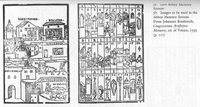(39) Nahuatl picture writing and memory

 Like present day websites, European “artificial memory” mnemonic systems utilized both extremely orderly alphanumeric and geometrical systems, and bizarre or incongruous images. Either too much alphanumeric and geometrical organization or too many bizarre images could make a memory image difficult to navigate. They were usually used for memorizing concepts in theology, rhetoric, logic, or grammar, and the idea of compiling time lines including events recorded separately in different parts of the world had been around since Roman times. Censorship prevented publication of Nahuatl picture writing in European books in the sixteenth century, but in manuscripts from the colonial period, with only slight changes in format the hieroglyphs were similar to European “artificial memory” illustrations and often easier to read. Indians had more experience with systems combining numbers and pictures and an educational system based on teaching them.
Like present day websites, European “artificial memory” mnemonic systems utilized both extremely orderly alphanumeric and geometrical systems, and bizarre or incongruous images. Either too much alphanumeric and geometrical organization or too many bizarre images could make a memory image difficult to navigate. They were usually used for memorizing concepts in theology, rhetoric, logic, or grammar, and the idea of compiling time lines including events recorded separately in different parts of the world had been around since Roman times. Censorship prevented publication of Nahuatl picture writing in European books in the sixteenth century, but in manuscripts from the colonial period, with only slight changes in format the hieroglyphs were similar to European “artificial memory” illustrations and often easier to read. Indians had more experience with systems combining numbers and pictures and an educational system based on teaching them.The page at the right is from the Codex en Cruz, and begins with the same ten years (1519-28) as The Garden of Delights/El Jardín de las Delicias. The page at the left is from Frances A. Yates, The Art of Memory (1966).


0 Comments:
Post a Comment
<< Home